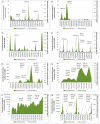Risk Levels of Toxic Cyanobacteria in Portuguese Recreational Freshwaters
- PMID: 29057822
- PMCID: PMC5666374
- DOI: 10.3390/toxins9100327
Risk Levels of Toxic Cyanobacteria in Portuguese Recreational Freshwaters
Abstract
Portuguese freshwater reservoirs are important socio-economic resources, namely for recreational use. National legislation concerning bathing waters does not include mandatory levels or guidelines for cyanobacteria and cyanotoxins. This is an issue of concern since cyanotoxin-based evidence is insufficient to change the law, and the collection of scientific evidence has been hampered by the lack of regulatory levels for cyanotoxins in bathing waters. In this work, we evaluate the profile of cyanobacteria and microcystins (MC) in eight freshwater reservoirs from the center of Portugal, used for bathing/recreation, in order to determine the risk levels concerning toxic cyanobacteria occurrence. Three of the reservoirs did not pose a risk of MC contamination. However, two reservoirs presented a high risk in 7% of the samples according to the World Health Organization (WHO) guidelines for MC in bathing waters (above 20 µg/L). In the remaining three reservoirs, the risk concerning microcystins occurrence was low. However, they exhibited recurrent blooms and persistent contamination with MC up to 4 µg/L. Thus, the risk of exposure to MC and potential acute and/or chronic health outcomes should not be disregarded in these reservoirs. These results contribute to characterize the cyanobacterial blooms profile and to map the risk of toxic cyanobacteria and microcystins occurrence in Portuguese inland waters.
Keywords: cyanobacteria; cyanotoxins; guidelines; microcystins; recreational freshwaters; risk levels.
Conflict of interest statement
The authors declare no conflict of interest.
Figures



References
-
- PNA Plano Nacional da Água—National Water Plan. Agência Portuguesa do Ambiente, Republica Portuguesa. [(accessed on 20 July 2016)];2015 Available online: http://www.apambiente.pt/?ref=16&subref=7&sub2ref=9&sub3ref=833.
-
- O’Neil J.M., Davis T.W., Burford M.A., Goblerc C.J. The rise of harmful cyanobacteria blooms: The potential roles of eutrophication and climate change. Harmful Algae. 2012;14:313–334. doi: 10.1016/j.hal.2011.10.027. - DOI
Publication types
MeSH terms
Substances
LinkOut - more resources
Full Text Sources
Other Literature Sources

